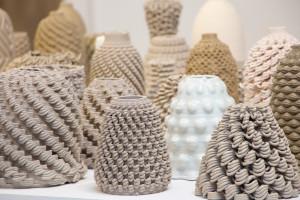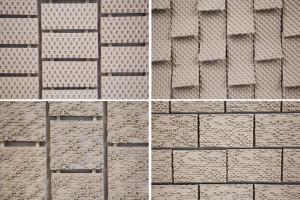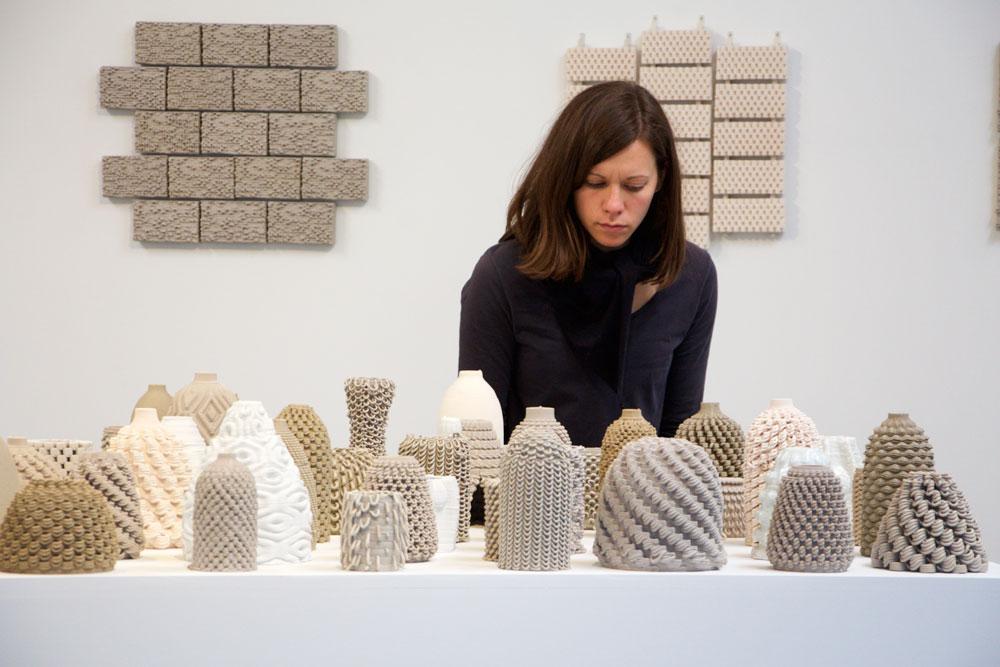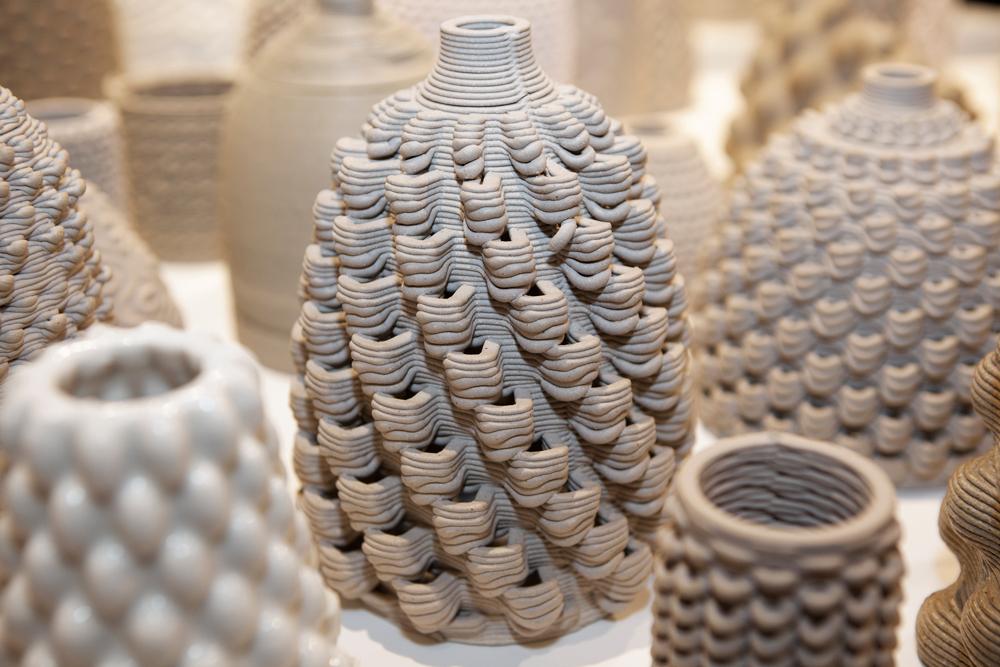 California-based Emerging Objects is possibly one of the studios that has experimented most deeply with 3D printing materials and processes, with several impressive projects published worldwide. Ronald Rael and Virginia San Fratello, the studio’s founders, initially experimented mostly with powder based materials and processes. Lately they have begun focusing on extrusion as well. Their latest GCODE.Clay project is specifically centered on creating full-body clay compressed with a servo motor.
California-based Emerging Objects is possibly one of the studios that has experimented most deeply with 3D printing materials and processes, with several impressive projects published worldwide. Ronald Rael and Virginia San Fratello, the studio’s founders, initially experimented mostly with powder based materials and processes. Lately they have begun focusing on extrusion as well. Their latest GCODE.Clay project is specifically centered on creating full-body clay compressed with a servo motor.
The GCODE.Clay collection is made up of a series of objects 3D printed in porcelain, bmix, terra-cotta, and recycled clay. The uniqueness of the design process is that it explores the creative potential of designing with G-code, the language in which people tell computerized machine tools how to make something.
“In this case,” they explain, “the 3D printer is pushed outside the boundaries of what would typically define the printed object, creating a series of controlled errors that create a new expressions in clay defined by the plasticity of the material, gravity and machine behavior.”
Aside from high-performance ceramics 3D printing by hybrid SLA processes, clay 3D printing by extrusion is typically defined by the layers of clay, whose striations are present on the surface of the 3D printed object. This is generally considered to be a flaw of extrusion clay 3D printing and efforts are being made to reduce the layer size by several ceramic 3D printer manufacturers. Building on their previous Meshmix Modern concept, where they celebrated the beauty and functionality of 3D printing of supports, Emerging Objects put the extruded layers at the center of their creation. The result is that the surface quality takes on the appearance of textiles, with clay being woven, threaded, curled, as it droops away from the surface.
“In each object, texture, pattern, and surface make the objects tactile, and gather light and shadow in beautiful ways,” the Emerging Objects team explained. “Architecture, lighting, and pottery all come to mind when considering the objects through several scales. Ceramic becomes soft to the eye, dynamic, with detail that could not be achieved by hand — yet the hand of the digital designer is present in every artifact.”
In addition to the vessels, a series of experiments in ceramic wall cladding assemblies were explored as well, possibly as a continuation of Emerging Objects’ research into 3D printable ” smart bricks”. Each assembly is hung using custom 3D printed hardware, and serve as prototypes for ceramic cladding systems for building. The cladding components are also engineered and designed to be weather resistant, sustainable, and to create a shade and water barrier as a building skin. Of course, as Ronald pointed out, one should not discount the necessity for aesthetics as well.
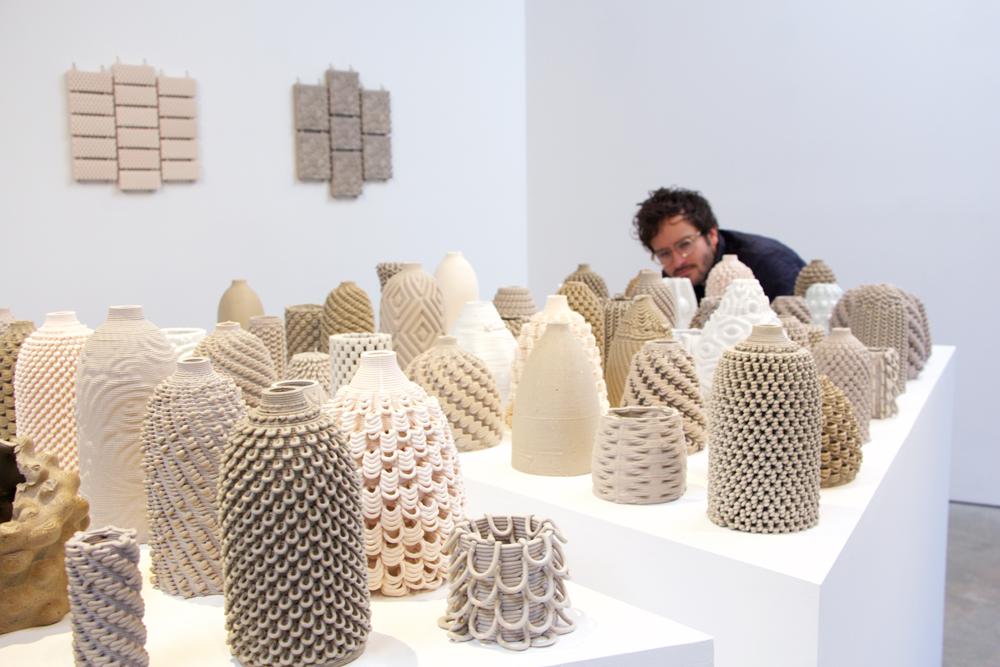 The GCODE.Clay collection, designed by Ronald Rael, Virginia San Fratello, Kent Wilson and Alex Schofield, was first exhibited at Space 2214, in Berkeley, California. The space’s inaugural exhibition investigating Pattern, Predictability, and Repetition explored the themes of repetition, and rote action — a defining peril of modernity. In this project, the unpredictability is the fundamental aspiration of the object making. Patterns emerge and disappear in the variations of the experiments explored. It is basically the exact opposite of what digital manufacturing usually does and the irony is that it was achieved by designing in machine language.
The GCODE.Clay collection, designed by Ronald Rael, Virginia San Fratello, Kent Wilson and Alex Schofield, was first exhibited at Space 2214, in Berkeley, California. The space’s inaugural exhibition investigating Pattern, Predictability, and Repetition explored the themes of repetition, and rote action — a defining peril of modernity. In this project, the unpredictability is the fundamental aspiration of the object making. Patterns emerge and disappear in the variations of the experiments explored. It is basically the exact opposite of what digital manufacturing usually does and the irony is that it was achieved by designing in machine language.
Subscribe to Our Email Newsletter
Stay up-to-date on all the latest news from the 3D printing industry and receive information and offers from third party vendors.
You May Also Like
Gorilla Sports GE’s First 3D Printed Titanium Cast
How do you help a gorilla with a broken arm? Sounds like the start of a bad joke a zookeeper might tell, but it’s an actual dilemma recently faced by...
Nylon 3D Printed Parts Made More Functional with Coatings & Colors
Parts 3D printed from polyamide (PA, Nylon) 12 using powder bed fusion (PBF) are a mainstay in the additive manufacturing (AM) industry. While post-finishing processes have improved the porosity of...
$25M to Back Sintavia’s Largest Expansion of Metal 3D Printing Capacity Since 2019
Sintavia, the digital manufacturing company specializing in mission-critical parts for strategic sectors, announced a $25 million investment to increase its production capacity, the largest expansion to its operations since 2019....
Velo3D Initiates Public Offering in a Bid to Strengthen Financial Foundations and Drive Future Growth
Velo3D (NYSE: VLD) has been among a number of publicly traded 3D printing firms that have attempted to weather the current macroeconomic climate. After posting a challenging financial report for 2023,...


